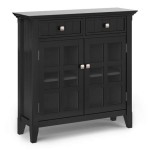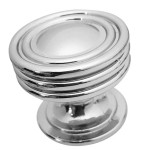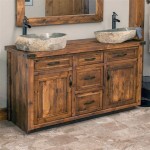How Big Should Cabinet Pulls Be? A Guide to Optimal Sizing
Selecting the correct size cabinet pulls is a crucial element in achieving both the aesthetic appeal and functional efficiency of kitchen, bathroom, or any other cabinetry. Overlooking this detail can result in hardware that feels awkward to use or appears disproportionate, detracting from the overall design. Determining the ideal size involves considering various factors, including cabinet dimensions, style preferences, and the practical needs of the users.
The function of cabinet pulls extends beyond merely opening and closing doors and drawers. They serve as tactile points of interaction, contributing to the user experience each time the cabinets are accessed. A well-chosen pull complements the cabinetry's aesthetic, while a poorly sized one can disrupt visual harmony and compromise usability. This article explores the key considerations for selecting appropriate cabinet pull sizes, providing a framework for making informed decisions that enhance both the form and function of cabinetry.
Understanding the Importance of Proportion
Proportion is paramount when choosing cabinet hardware. A pull that is too small can appear insignificant and may be difficult to grip, while an oversized pull can overwhelm the cabinet and create a bulky or unbalanced appearance. The goal is to achieve a visual equilibrium where the pull complements the cabinet without dominating it.
Cabinet size is a primary determinant of appropriate pull size. Smaller cabinets, typically those used for upper cabinets or narrow drawers, generally benefit from smaller pulls. Conversely, larger cabinets, such as base cabinets or wide drawers, require larger pulls to maintain visual balance and provide adequate leverage for opening. A common guideline suggests that the pull should be approximately one-third the width of the cabinet door or drawer it adorns. However, this is merely a starting point, and individual preferences and cabinet styles can influence the final decision.
The style of the cabinetry also plays a crucial role in determining the ideal pull size. Modern, minimalist designs often feature sleek, understated pulls that emphasize clean lines. These may be smaller in scale and positioned discreetly on the cabinet. Traditional or ornate cabinetry, on the other hand, may warrant larger, more decorative pulls that enhance the overall aesthetic. The pull's finish should also complement the cabinetry's color and material, ensuring a cohesive and visually appealing design.
Beyond the general proportion, consider the style of the pull itself. A simple bar pull often appears more substantial than a knob of the same overall length. A cup pull, typically used on drawers, visually occupies more space than a similarly sized bar pull, requiring adjustments in the overall size consideration to maintain appropriate scale.
Measuring Techniques and Guidelines
Accurate measurements are essential for ensuring a proper fit and aesthetically pleasing result. The center-to-center measurement, which is the distance between the screw holes on the pull, is the critical dimension to consider when replacing existing hardware. This measurement must match the existing hole spacing on the cabinet to avoid the need for drilling new holes.
When installing new cabinetry or replacing hardware with a different style, several guidelines can assist in determining the appropriate center-to-center measurement. For drawers less than 12 inches wide, a single pull centered on the drawer is typically sufficient. For drawers between 12 and 24 inches wide, a pull with a center-to-center measurement of approximately 3 to 5 inches is generally recommended. For drawers wider than 24 inches, larger pulls with center-to-center measurements of 6 inches or more may be necessary to provide adequate leverage and maintain visual balance. Alternatively, two smaller pulls can be used, spaced evenly across the drawer front.
For cabinet doors, the placement and size of the pull can vary depending on the door's size and style. On standard-sized upper cabinet doors, a pull with a center-to-center measurement of 3 to 4 inches is often appropriate. On taller or wider doors, a larger pull may be necessary to maintain proportion. The pull is typically positioned along the stile of the door, the vertical frame member, at a comfortable height for access.
It is important to consider the overall height and reach of the individuals who will be using the cabinets. If elderly individuals or those with mobility limitations will be using the cabinets, larger, easier-to-grip pulls may be preferable. Avoid pulls that are too small or require excessive force to operate, as these can pose challenges for individuals with limited dexterity. Prioritizing ergonomics ensures that the cabinetry is accessible and functional for all users.
Before committing to a specific pull size, it is advisable to create templates or mock-ups to visualize the hardware on the cabinets. Cut pieces of cardboard to the dimensions of the desired pulls and temporarily attach them to the cabinet doors and drawers using tape. This allows for a realistic assessment of the pull's size and placement before drilling any holes. Experiment with different sizes and positions to determine the most aesthetically pleasing and functional configuration.
Material, Finish, and Style Considerations
Beyond size, the material, finish, and style of the cabinet pulls significantly impact the overall aesthetic of the cabinetry. The material of the pull should be durable and suitable for the intended use. Common materials include stainless steel, brass, bronze, chrome, and various alloys. Each material offers different levels of resistance to corrosion, wear, and tear. Stainless steel is a popular choice for its durability and resistance to rust, while brass offers a classic, elegant look. The choice of material should also complement the overall design style of the kitchen or bathroom.
The finish of the pull can further enhance its visual appeal. Polished chrome and brushed nickel are popular finishes for modern designs, offering a sleek and contemporary look. Oil-rubbed bronze and antique brass finishes are often used in traditional or rustic settings, providing a warm and inviting feel. Matte black finishes are increasingly popular for their versatility and ability to complement a wide range of cabinet colors and styles.
The style of the pull should be consistent with the overall design aesthetic of the cabinetry and the surrounding space. Simple bar pulls are a common choice for modern or minimalist kitchens and bathrooms, offering a clean and understated look. Cup pulls are often used on drawers in traditional or farmhouse-style settings, adding a touch of vintage charm. Knobs are a versatile option that can be used on both doors and drawers, and come in a wide variety of shapes, sizes, and materials.
Consider the other hardware in the room when selecting cabinet pulls. The faucets, light fixtures, and other accessories should be coordinated to create a cohesive and harmonious design. Mixing different metal finishes can be effective, but it requires careful consideration to ensure that the overall look is balanced and intentional. A general rule of thumb is to limit the number of different metal finishes used in a single space to two or three.
The texture of the cabinet pulls can also contribute to the overall tactile experience. Smooth, rounded pulls are comfortable to grip and easy to clean, while textured pulls can provide a more secure grip, especially for individuals with limited dexterity. The texture of the pull should also complement the texture of the cabinetry and other surfaces in the room.
Ultimately, the choice of cabinet pull size, material, finish, and style is a matter of personal preference. However, by considering the factors outlined in this article, individuals can make informed decisions that enhance both the form and function of their cabinetry. Paying attention to proportion, measuring accurately, and coordinating the hardware with the overall design aesthetic will result in a cohesive and visually appealing space.

Hardware Guide

How To Choose Hardware Pull Size For Your Cabinets
How To Choose The Best Size Pulls For Your Cabinets Trubuild Construction
Cabinet Hardware Sizing Guide The Knobbery Door Bath Accessories Faucets Furniture Knobs And Pulls

What Size Knob Or Pull Should I Get The Shop

Comprehensive Guide To Cabinet Hardware Size Placement Handles More

The Right Length Cabinet Pulls For Doors And Drawers Porch Daydreamer
Cabinet Hardware Sizing Guide The Knobbery Door Bath Accessories Faucets Furniture Knobs And Pulls

Hardware Guide

The Right Length Cabinet Pulls For Doors And Drawers Kitchen Hardware








